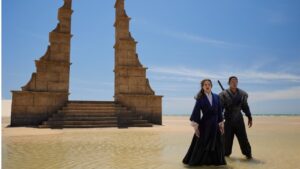MINOR SPOILERS FOR THE WHEEL OF TIME THROUGH BOOK FOUR: THE SHADOW RISING, AND POTENTIAL SPOILERS FOR THE WHEEL OF TIME SEASON THREE, AHEAD!
The best (and most criminally underrated) fantasy series on television, Amazon’s The Wheel Of Time, is returning for its third season in less than two months, and the streamer has dropped first-look images showcasing new locations and characters, key moments from the pages of Robert Jordan’s The Shadow Rising, and a wardrobe’s worth of bold, beautiful costumes designed by the absolute madwoman (complimentary) that is Sharon Gilham. Rand al’Thor and the rest of the Emond’s Field Five feature heavily, while characters like Alanna Mosvani and Liandrin Guirale are nowhere to be seen, indicative of the series-wide shift in focus away from the Aes Sedai (including Rosamund Pike’s Moiraine Damodred) onto the younger cast led by Josha Stradowski’s Rand, happening in season three. This shift, which doesn’t occur in the books because Rand is the clear protagonist from the get-go, is something some fans have eagerly anticipated and others have dreaded, and I am very interested to see if The Wheel Of Time can achieve a healthy balance. Let’s see what we can glean from the new images.

Rand, Perrin Aybara, and Mat Cauthon get together for drinks, something they haven’t had a chance to do since they left Emond’s Field in season one, episode one. This shot has to be from very early in the season, because the three boys’ storylines obviously haven’t yet diverged, with Rand heading off to the Aiel Waste, Perrin returning to Emond’s Field, and Mat apparently accompanying Nynaeve al’Meara and Elayne Trakand to the city of Tanchico. Based on the architecture, the setting is probably the city of Tar Valon, which tracks with what we know (from descriptions of footage shown at CCXP in Brazil) about one of the first major set-pieces in season three, a battle between the Aes Sedai and a mutinous contingent of Darkfriends led by Liandrin Guirale that moves from the White Tower out into the streets of Tar Valon.

In what looks to me like the same tavern in Tar Valon, Elayne and the Aiel warrior Aviendha are seen sipping drinks and staring into each other’s eyes. This image immediately caught my eye for the simple fact that I’m queer, and like many queer readers, felt that there were definite undertones between these two characters even in the books, where Elayne and Aviendha come to regard each other as “first-sisters”, an Aiel term for two women who are not of the same mother but are as close as if they were kin. In Robert Jordan’s expansive world, there are a fair number of female characters one might be tempted to categorize as canonically queer characters, although unfortunately, nine times out of ten, I feel it would be more accurate to describe these characters as overtly heterosexual women thrust into homoerotic situations by their creator for no other reason than that he was a straight man who was not particularly subtle about his fetish for women making out with each other (that, and women being spanked: there’s so much spanking in The Wheel Of Time). So in spite of all the evidence that would seem to support queer interpretations of Elayne and Aviendha’s characters and relationship, I genuinely do not think Jordan himself thought of them as anything but straight.
That being said, the television adaptation has already canonized one relationship that was ambiguous in the books, between Moiraine and Siuan Sanche. Jordan wrote that the two women were ‘pillow-friends’ during their youth — the Wheel Of Time equivalent of saying they ‘experimented in college’ — referring to a practice amongst the isolated female Novices at the White Tower of finding comfort in same-sex partners: only, Jordan emphasizes, because there are no men around. It’s understood in the books that Novices are supposed to ‘mature’ out of desiring these same-sex relationships, with those who don’t often framed as having sinister motives. Moiraine and Siuan, however, are middle-aged women in the show, and their love is portrayed as just that, love, not a ‘phase’ either woman is looking to outgrow. There are also several other explicitly queer characters on the show, both male and female. So I have faith that fans of the “Avilayne” pairing will not be let down.

Although it’s hard to tell for certain where this shot of the Forsaken Lanfear fits into the timeline we’re piecing together, I’m going to put it here because the architecture in the background feels more like Tar Valon than any of the other locations we know we’ll be visiting in season three, and it would be very much in-character for Lanfear to stalk Rand while he’s out with friends. I’m gonna tell you my theory: Lanfear is keeping just enough distance between herself and Rand so as not to make her presence near him known to the other Forsaken who may be watching, but Rand notices her in this scene – and this is the moment she turns away, with an almost sorrowful expression on her face that says she could protect him from what’s coming, if he only let her back into his heart. By the time he reaches the door, she’ll have vanished, of course, leaving him shaken up. You can remind me come March if I was right or if this shot is from an entirely different scene.

Siuan Sanche, the Amyrlin Seat of the Aes Sedai, throws out her arm and channels a complex weave using red and gold threads of the One Power in this image, which I feel pretty confident in saying is from the aforementioned battle with Liandrin and her cronies. The woman beside Siuan is Alanna (yes, I lied when I said she was nowhere to be seen, though to be fair, it is only a bit of her shoulder; but those gold epaulets are clearly the same ones she’s wearing in the teaser trailer, shown below). Siuan is channeling upwards in this shot, which leads me to believe that Liandrin is on the mezzanine encircling the round Hall of the Sitters, or has brought the roof down on their heads.


This striking image of Elayne Trakand and Nynaeve al’Meara flanking Egwene al’Vere, all three on horseback and wearing impractical armor over luxurious gowns, can only be from one of the two Accepted Tests we haven’t yet seen, Egwene’s or Elayne, and I’m gonna take a wild guess and say it’s Egwene’s based on the fact that she’s front-and-center, and dressed as the Amyrlin Seat (Flames of Tar Valon are emblazoned on her armor and embroidered on her gown; she’s also wearing a ring identical to Siuan’s; the gemstone necklace is a curious accessory, unique to Egwene but with no immediately apparent symbolism). In the books, the last of the three alternate universes Egwene enters during her Accepted Test is one in which she is Amyrlin and must preside over the trial and gentling of Rand al’Thor, a captive of the Red Ajah.
The sense I’m getting from the show’s version, or at least from this still-frame, is that Egwene and her companions are hunting Rand themselves, and will engage him in battle. Whereas in the books, this stage of the Test is built around Egwene’s fear of Darkfriends amongst the Aes Sedai, I think the show will make her greatest fear the future that awaits Rand (not to mention the whole world), if she can’t figure out how to stop him from going mad like all male channelers before him: and to that end, I think Rand will kill the alternate universe versions of Elayne and/or Nynaeve in his madness, with Egwene narrowly escaping.

Next up, we see Rand practicing sword forms with Moiraine’s Warder, Lan Mandragoran — a scene from the first chapter of book two, The Great Hunt, that didn’t make it into season two, although Rand did pick up a few moves from an elderly blademaster in the city of Cairhien, and Lan taught him one of the better-known forms, ‘Cat Crosses The Courtyard’, before his audience with the Amyrlin Seat. Fans of their relationship will be pleased to have the sword training subplot picked up again, and hopefully afforded a little more time and space, in season three. This was one of two clips shown to the audience at CCXP (the other being a preview of the battle in Tar Valon), and descriptions of the footage place Moiraine and Egwene in the same scene, suggesting that this takes place during their journey from Tar Valon to the Aiel Waste.

This reverse angle of the opening shot from the teaser trailer gives us our first look at several new characters from the Aiel Waste, including Nukâka Coster-Waldau as the Wise One Bair, Synnøve Macody Lund as the Malkieri refugee turned Maiden of the Spear Melindhra, and Björn Landberg as clan chief of the Taardad Aiel, Rhuarc. The teaser reveals that they’re looking out over Rhuidean, a city built shortly after the Breaking of the World, the ruins of which have been put to use by the Aiel as a testing ground for women training to become Wise Ones and men looking to become clan chiefs. The city is home to several ter’angreal, magical constructs with specific functions, including one that shows visions of possible directions a person’s life may take, and another that allows a person to relive historical events through the eyes of their ancestors. Rand’s journey to fulfil the prophecies of the Dragon Reborn will lead him through Rhuidean, while Moiraine will learn there what steps she must take to keep him alive until the Last Battle.
Rhuidean is widely regarded as one of the most memorable sequences in the entire fourteen-volume book series, and while I expect it to play out a bit differently in the show for a number of reasons (namely, the apparent absence of Mat Cauthon and the inclusion of Moiraine’s perspective), I hope what we get from the adaptation is similarly rich and immersive. The show has tried to simplify Robert Jordan’s complex magic system and worldbuilding for general audiences, but three seasons in, if you’re still watching, chances are you’re already invested in the story and won’t be turned off suddenly by an influx of new information.

Moiraine channels golden threads of the One Power into a glowing sphere, potentially a miniature version of one of the two enormous crystal balls that collectively form the ‘Choedan Kal’, a sa’angreal (an object that allows a channeler to channel more of the One Power than they would normally be able to). The Choedan Kal is the most powerful sa’angreal ever made, and requires two ter’angreal to unlock it, referred to as access keys. I suspect what we’re looking at in the image above is Moiraine attempting to unlock the Choedan Kal using just one of the keys, possibly during a confrontation with Lanfear or another of the Forsaken.

Queen Morgase Trakand of Andor and her Aes Sedai advisor Elaida do Avriny a’Roihan make their debut in this shot of the two entering the White Tower, presumably looking for Morgase’s daughter Elayne, who as far as they’re aware is still missing after being kidnapped from the Tower by Liandrin in season two and whisked away to Falme on the other side of the world. By the time they arrive, I fully expect Elayne to be long gone from Tar Valon, this time on a top-secret mission to the city of Tanchico, hunting Liandrin and her cabal of Darkfriends (more on that in a minute). The ensuing stand-off between Morgase and Siuan is only recounted after the fact in the books, but leads to Elayne giving Mat Cauthon a letter to take to her mother in the city of Caemlyn before she sets out again, which ends up being a surprisingly fun little subplot; not crucial by any means, so I won’t be shocked if it’s cut from the show, but what is crucial is the emergence of Mat’s luck (he’s essentially got the same powers as Marvel Comics’ Domino), through episodes like the quarterstaff fight with the Trakand boys, the chase across the rooftops of Tar Valon, and the encounter with Aludra the Illuminator, which are all part of this subplot.
Morgase’s advisor Elaida, an Aes Sedai of the increasingly powerful Red Ajah that oversees the systematic extermination of male channelers, is someone to keep an eye on – and not just because The Wheel Of Time was fortunate enough, speaking of luck, to nab Oscar-nominee Shohreh Aghdashloo for this role. Elaida is one of the most important characters in the entire series, a complex antagonist to Siuan Sanche who sees herself as the leader the Aes Sedai desperately need if they’re to defeat the Dark One at the Last Battle: because they’re sure as hell not going to rely on a male channeler like Rand al’Thor, not if Elaida has any say in the matter. The White Tower she’ll be returning to in the show, after years of living in Caemlyn, is one that will have just been rocked to its foundations by an attack from within. The Red Ajah, which Liandrin belonged to, will be eager to pin the blame on Siuan, but needs a charismatic representative with no connections to Liandrin to make the argument. There’s no better moment for Elaida to step in and fill that role.

In the books, book three to be precise, Siuan assigns Egwene, Nynaeve, and Elayne with a top-secret mission: following Liandrin to the city of Tear, where (unbeknownst to Siuan) Liandrin is going to try and capture Rand with the help of the Forsaken Be’lal, who is disguised as a High Lord of Tear. Mat, as I mentioned, goes to Caemlyn to deliver Elayne’s letter to the Queen, but while there, learns that the girls are walking into a trap, and makes his way to Tear in the company of the gleeman Thom Merrilin. Liandrin ends up escaping to the city of Tanchico, where Nynaeve and Elayne continue their hunt for her in book four, The Shadow Rising, with Thom as their escort, while Egwene goes to the Aiel Waste with Rand. The television adaptation is, as far as I can tell, having Nynaeve and Elayne head straight to Tanchico from Tar Valon, bypassing Tear entirely, and Mat will be joining them – though whether from the outset of their adventure or, as in book three, after realizing that they’re in danger and coming to save them, remains to be seen. There’s a very strong chance that Tanchico is where we’ll be reunited with Thom, last seen on the show in season one and presumed dead by much of the general audience, but returning at long last for season three. And obviously but rather oddly, the seer Min Farshaw is here as well.
Tanchico is the capital city of the nation of Tarabon, which in recent years has been torn to pieces by a civil war instigated and prolonged by the Whitecloaks in neighboring Amadicia, who hope to destabilize the region (in the books, the reason why the Whitecloaks are in Falme is to try and set up another vassal state north of Tarabon with which to slowly blockade the larger nation into submission). Tarabon has two rulers, a male King and an elected female ‘Panarch’, who governs from a palace complex in the hills above Tanchico. This palace houses the world’s largest museum, containing relics dating back thousands of years to before the Breaking of the World – including several ter’angreal. Is one of these the object wrapped in cloth that Mat, Nynaeve and Min are seemingly looking to purchase or barter for in the image above? And who is the man they’re dealing with, anyway? My bet’s on Juilin Sandar, the rat-catcher whom the girls hire to spy for them in Tear.
Well, that’s everything. What I’m hoping to see from the next batch of images released by Amazon is our first look at what’s going on in the Two Rivers, along with some more new characters like Faile Bashere and Gawyn Trakand, and familiar faces like Thom Merrilin, Tam al’Thor, Liandrin Guirale, Moghedien, Verin Mathwin, Dain Bornhald, and Logain Ablar. How about you? Who or what got you most hyped out of these new images and who or what are you still hoping to see before season three arrives this coming March? Share your own thoughts, theories, and opinions, in the comments below!

















